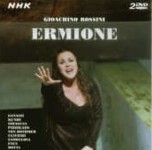Was the audience at the premiere of this opera in 1819 half-dead or half-deaf? It ran a few performances but was so badly received that Rossini withdrew it entirely and never attempted to revive it, claiming it was for his “posterity”. (There are no contemporary press reports!) It may not be going too far to refer to it as a masterpiece.
The crazed, title character is unhinged from the start, getting worse as the opera goes on, manipulating two lovers, forcing one to kill the other and then immediately regretting it. Perhaps the first opera to explore bi-polar behavior (or the manner in which war–in this case the Trojan War–can tear apart peoples’ psyches), maybe the Neapolitans simply found it too much. All of the characters are obsessed. Love, both requited and unrequited, is explored and mixed with politics–but isn’t this opera at its most epitomized?
The sheer sound of the work–plenty of winds, a chorus behind the closed curtain that interrupts the overture, huge “numbers” that do not follow the rules of the day (arias are disrupted by choruses; tempos change suddenly and frequently; cabalettas are put off; recitatives, particularly the late ones for Ermione, are devoid of melodic or rhythmic thrust and seem more stream-of-consciousness)–perhaps confused the otherwise sophisticated San Carlo crowd. But all revivals of the work in the past 20 years have been successful; at last Ermione is getting its due.
This production from the 2008 Pesaro Festival works well. Carla Teti’s updated costumes are attractive and neither add to nor detract from the drama. Graziano Gregori’s scenery is uncomplicated, indeed minimal. The bare stage floor can be raised and lowered by cables a section at a time, changing place and mood; an opening in the back wall allows more action to unfold without getting in the way of the principal singers; the characters’ predicaments are kept front and center and Daniele Abbado’s stage direction is clean, clear, and uncomplicated.
In the title role is mezzo Sonia Ganassi, a startling and pleasant surprise. Granted, Rossini wrote the part for Isabella Colbran when her powers were waning, so the role does not sit particularly high, but the prospect of hearing a mezzo normally associated with Rosina and Cenerentola in the part did not cheer me up. However, she is amazingly vivid, turning out roulade after roulade, spitting venom and ranting to great effect while throwing her entire body into the process. Marianna Pizzolato as Andromaca (captive of and loved by Pirro, who was betrothed to Ermione, and who threatens to kill her son if she does not give in to his advances) sings with fluency, punch, and nobility.
The two lead tenor parts are monstrously high and florid. Gregory Kunde’s voice has darkened and isn’t always smoothly produced, but as Pirro he’s fearless from A below middle-C to the D above high-C, and you can’t help but be impressed by his vigor. He also manages real warmth in tender moments.
Antonio Siragusa, who sings Oreste, owns a voice of an entirely different hue: filled with vibrato and produced through the mask, it has a somewhat nasal quality, but despite being unflatteringly costumed (bald as an eagle and looking cartoonish as such), he makes a fine case for the character, dispatching his florid music and high notes with ease. The others in the cast are good enough–they’re mostly filler and exist only in recitative.
Roberto Abbado leads the Bologna and Prague forces occasionally as if the opera were composed later in the Romantic era, but Rossini wanted this work to shock or he wouldn’t have set it to such ferocious music. Picture and sound are superb; subtitles are available in all major European languages. The only competition is from Kultur, in a somewhat off-putting Glyndebourne production with Anna Caterina Antonacci even better in the title role, but with the other singers not as strong. This DVD is highly recommended.
































